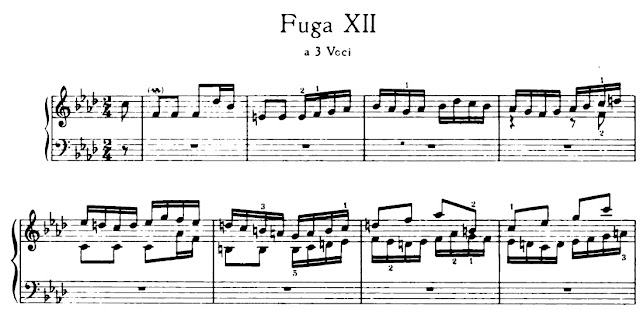 Bach intended Book II of The Well Tempered Clavier to fulfill the same uses as Book I; as a teaching aid for keyboard technique, theory and composition. But it also served as a showcase for him as a composer.While he was an acknowledged master of the compositional techniques of counterpoint (his works were called 'learned', not necessarily a compliment as used by some), he also knew the recent trends and the changes that were happening in musical styles.
Bach intended Book II of The Well Tempered Clavier to fulfill the same uses as Book I; as a teaching aid for keyboard technique, theory and composition. But it also served as a showcase for him as a composer.While he was an acknowledged master of the compositional techniques of counterpoint (his works were called 'learned', not necessarily a compliment as used by some), he also knew the recent trends and the changes that were happening in musical styles.Book II has more difficulties and is longer than Book I, and has not been as popular with players or listeners. But there are treasures to discover if one is willing.
Prelude and Fugue No. 7 In E-flat Major BWV 876 - This prelude has the feeling of flowing eighth notes throughout. It is not made up of themes, but consists of continuous movement that appears free from drama or overt tension.
The 4-voiced fugue begins with a subject that is repeated 12 times throughout.
Prelude and Fugue No. 8 In D-sharp Minor BWV 877 - The Prelude No. 8 in Book I was written in E-flat minor, while Fugue No. 8 of Book I was written in D-sharp minor, probably as a way for Bach to show the advantages of his well- tempered keyboard, as these 2 keys are theoretically different, but on the keyboard are only different in appearance on the music page. This Prelude/Fugue pair are written in the same key of D-sharp minor. As there was a separation of about 20 years between the composition of the books, the issue of which tuning to use may have been pretty much decided in the favor of well -temperament and Bach saw no need to emphasize it. Written in 2 voices, this prelude is similar to a 2-part invention, with its difference being in its length and complexity. The first 16 measures are to be repeated, as are the final 20 measures, thus the prelude is in binary form that is similar to what Bach used in some of the dance suites.
The 4-voiced fugue has a short two-measure subject that is repeated 16 times. There are a total of 8 episodes that are free of any subject
Prelude and Fugue No. 9 In E Major BWV 878 - This prelude moves along in 3 voices throughout, with the upper and middle voices contributing somewhat more thematic material than the lowest voice. It has two sections that are repeated.
The fugue that follows is in 4 voices. The subject consists of 5 notes with each voice entering directly after the preceding voice. There is no rush, as the fugue unfolds in a moderate tempo.
Prelude and Fugue No. 10 In E Minor BWV 879 - In two voices throughout, an extended two-part invention. The prelude has two sections which are repeated, with the second section being longer. Trills in one hand help to define that voice while the opposing voice has its say.
A 3-voiced fugue that has the subject begin with an upbeat of the 2nd and 3rd notes of a triplet. It is rather a long subject at six measures that covers an octave. Bach uses this theme to garner interest even before the fugal entry begin. This subject occurs nine times during the fugue with no changes to it. There are six episodes in the fugue that do not contain the subject within it. The pace of the fugue is not fast, but it does have movement to it by way of the staccatos and triplets.
Prelude and Fugue No. 11 In F Major BWV 880 - A prelude in a pastoral, calm mood that begs to be played legato with no accents. This prelude reminds me somewhat of the beginning of the Prelude No. 7 in E-flat BWV 852 of Book I.
The 3-voiced fugue is written in 6/16 time, a signature that shows the basic pulse is sixteenth note triplets, 2 triplets to the bar. The bouncing subject is stated 8 times during the fugue. Most of the fugue is taken up by the six episodes.
Prelude and Fugue No. 12 In F Minor BWV 881 - The prelude begins meditatively, but with shifts into the major, the prelude has an underlying energy that may lead to some performers performing it too fast. This is another prelude from Book II that is in binary form, and as Bach develops sections of this prelude, it shows that it was a form that lead to the development of sonata-allegro form with later composers.
The character of the 3-voiced fugue as well as its 2/4 time signature gives the opportunity to increase the tempo. The subject appears 9 times, with 6 subject-free episodes. Much of Bach's music derives from dance forms that were old in his time, and this fugue has a sway to it that shows that derivation.













No comments:
Post a Comment